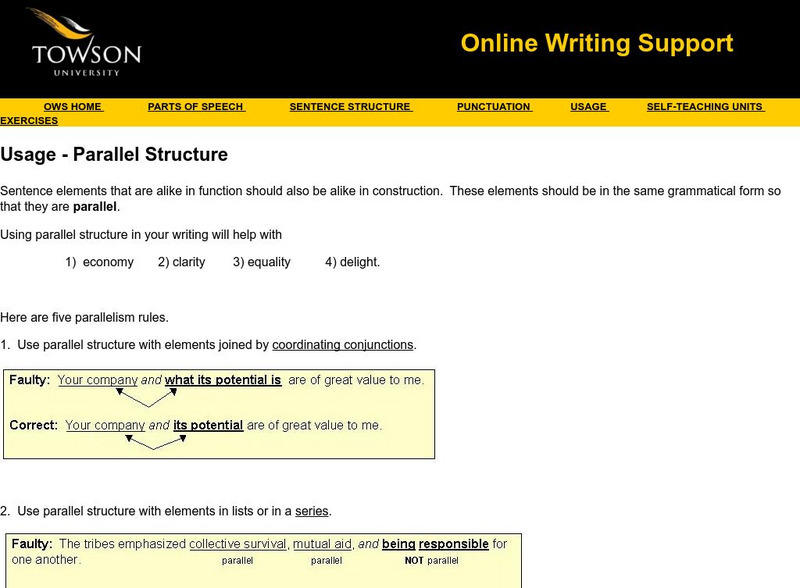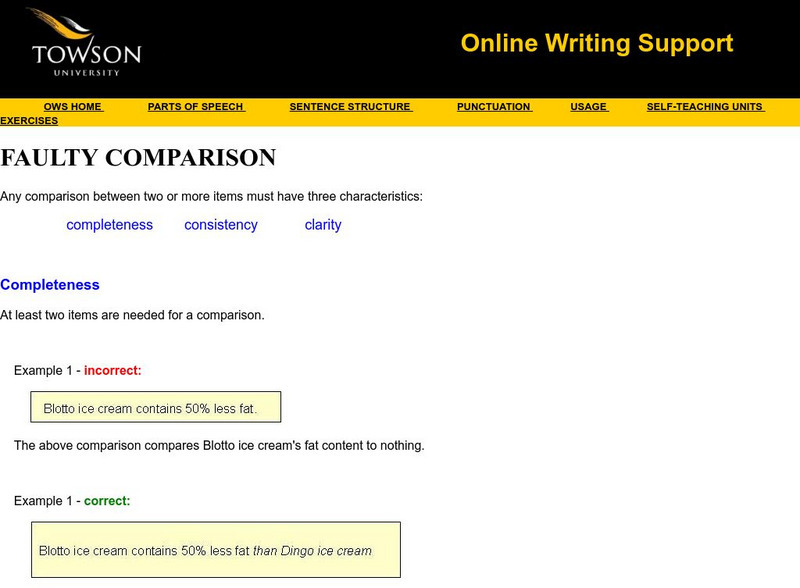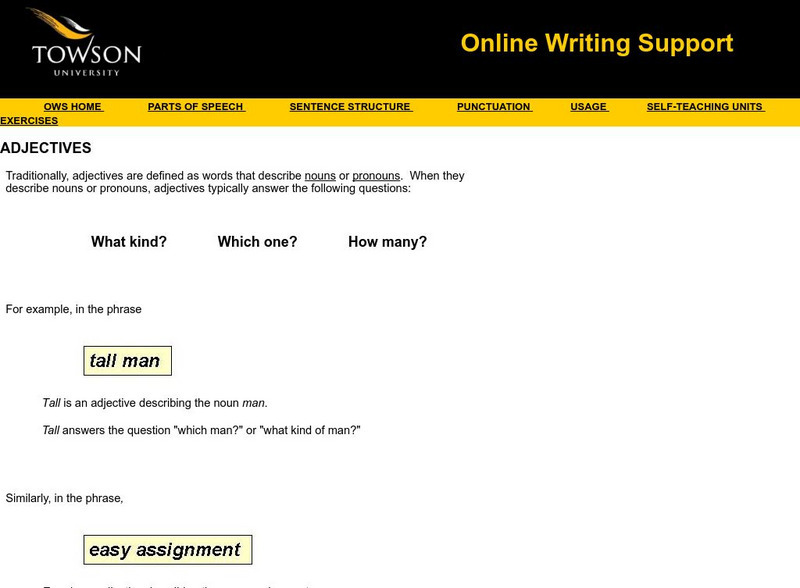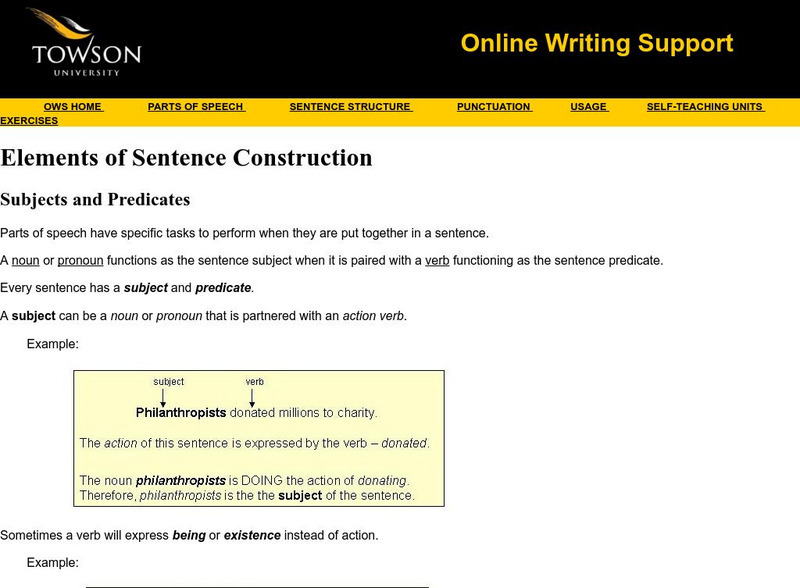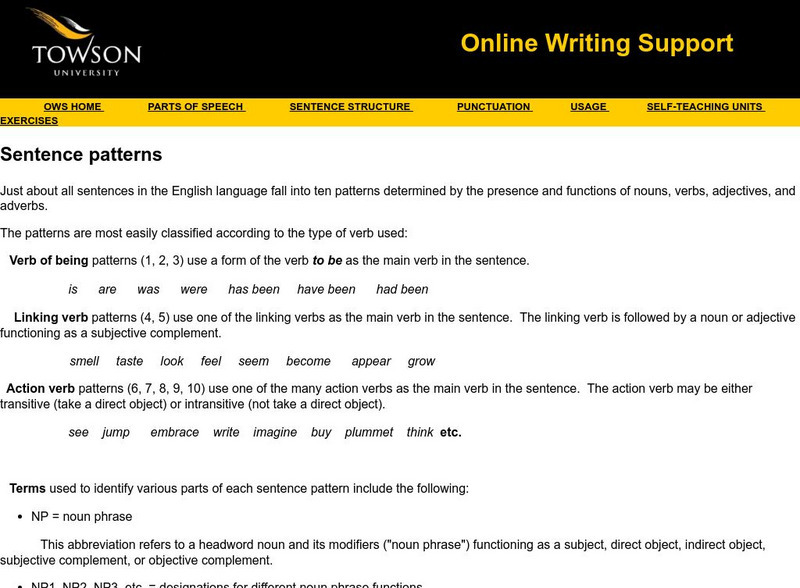Towson University
Towson University: Ows: Avoiding Comma Splices and Fused Sentences
This entry explains and provides examples of comma splices and fused sentences and how to fix them.
Towson University
Towson University: Online Writing Support: Avoiding Shifts
This entry focuses on avoiding shifts when writing sentences including shifts in verb tense, mood, number, person, discourse, and sentence structure. It provides explanation and examples of each type of error and explanation and examples...
Towson University
Towson University: Online Writing Support: Usage Parallel Structure
This entry defines parallel structure and provides the five rules of parallel structure complete with explanation and examples.
Towson University
Towson University: Online Writing Support: Faulty Comparison
This entry explains that at least two items are required for a comparison and each has three characteristics: completeness, consistency, and clarity. It provides examples of errors in the characteristics and explains how to fix them...
Towson University
Towson University: Online Writing Support: Verb Tense Consistency
This entry focuses on verb tense consistency in sentences, paragraphs, and essays by explaining the importance of maintaining verb tense throughout each and providing examples of each.
Towson University
Towson University: Online Writing Support: Links to Commonly Confused Words
This entry provides links to an extensive list of commonly confused words, each of which is explained with examples. L.11-12.4 Word Meanings
Towson University
Towson University: Online Writing Support: Parts of Speech
This entry provides links to information about the correct usage of various parts of speech, complete with examples.
Towson University
Towson University: Online Writing Support: Parts of Speech
This entry discusses the parts of speech in two major classes: content parts of speech and function parts of speech. Each is explained and examples are provided.
Towson University
Towson University: Online Writing Support: Nouns and Their Functions
This entry focuses on nouns and their functions as subjects, direct objects, indirect objects, objects of prepositions, subjective complements, objective complements, and appositives.
Towson University
Towson University: Online Writing Support: Adjectives
This entry focuses on adjectives including their functions, questions they answer, and comparative and superlative forms. Each is accompanied by an explanation and examples.
Towson University
Towson University: Online Writing Support: Prepositions
This entry focuses on prepositions, prepositional phrases, and particles including defining and providing examples of each. It also offers an explanation of the difference between prepositions and particles and lists of common...
Towson University
Towson University: Online Writing Support: Conjunctions
This entry focuses on the kinds of conjunctions including coordinating, correlative, subordinating conjunctions and conjunctive adverbs and the punctuation needed with each kind. It explains, gives examples, and provides lists of each kind.
Towson University
Towson University: Online Writing Support: Qualifiers /Intensifiers
This entry defines qualifiers/intensifiers (very, too, so, quite, rather), explains their purpose, and provides examples.
Towson University
Towson University: Online Writing Support: Verbals
This entry defines verbals, gerunds, participles, and infinitives; discusses each their different functions in sentences, and provides examples of each.
Towson University
Towson University: Ows: Dependent Clauses: Adverbial, Adjectival, Nominal
This entry defines dependent clauses including Adverbial, Adjectival, and Nominal; explains and lists their common introductory words, and provides examples of their uses in sentences.
Towson University
Towson University: Online Writing Support: Sentence Structure
This page offers a list of links to entries about sentence structure including elements of sentence construction, sentence types and punctuation, connectors, sentence patterns, pattern transformations, and active/passive voice.
Towson University
Towson University: Online Writing Support: Elements of Sentence Construction
This entry focuses on the Elements of Sentence Construction including subjects and predicates, phrases and clauses, compound sentence elements, and avoiding fragments, run-ons, and fused sentences.
Towson University
Towson University: Ows: Kinds of Sentences and Their Punctuation
This entry focuses on the kinds of sentences and how they are punctuation including simple, compound, complex, and compound-complex sentences.
Towson University
Towson University: Online Writing Support: Sentence Patterns
This entry explains sentence patterns and lists the 10 sentence patterns that cover most sentences including examples of each.
Towson University
Towson University: Online Writing Support: Sentence Pattern Transformations
This entry focuses on sentence pattern transformations including to active/passive voice, cleft, interrogative with yes or no answer, negative, emphasis, and to interrogative, imperative, or exclamatory. It includes an explanation and...
Towson University
Towson University: Online Writing Support: Active/passive Voice
This entry explains active and passive voice and how to change active to passive and passive to active in sentences. It provides detailed examples of each.
Towson University
Towson University: Online Writing Support: Punctuation
This page provides links to punctuation reference materials for apostrophes, colons, dashes, commas, parentheses, italics, quotation marks, and semicolons.
Towson University
Towson University: Online Writing Support: Apostrophe
This entry explains and provides examples of when and how to use the apostrophe to show ownership and to form the plural of letters, numbers, and signs used as words. It also explains when not to use apostrophes such as with the pronoun...
Towson University
Towson University: Online Writing Support: Colon
This entry focuses on the when and how to use a colon including to formally introduce a list, between two independent clauses, before a formal appositive, and between hour and minute / chapter and verse. It includes detailed examples of...




